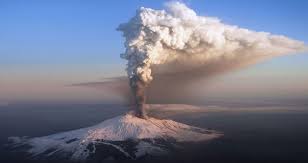
A bit of history – Mount Etna
Il Monte Etna, in Sicilia (3.329 metri di altezza – la più alta montagna a sud delle Alpi), è uno dei più attivi vulcani del mondo, con ben cinque crateri. Nel 2013 l’UNESCO l’ha nominato Patrimonio dell’Umanità. Tra le maggiori eruzioni vi è quella del 2 novembre 1928 – la più distruttiva del secolo scorso – che in pochi giorni distrusse la cittadina di Mascali. Quella del 1669 era durata 122 giorni ed aveva emesso un volume di lava di circa 950 milioni di metri cubi. L’eruzione del 1971 distrusse l’Osservatorio Vulcanologico e la funivia dell’Etna e quella del 1991 fu la più lunga del secolo – 473 giorni! E in seguito all’eruzione del 16 marzo di quest’anno sono rimaste ferite dieci persone incluso un team della BBC.
I detriti vulcanici rendono la terra estremamente fertile per l’agricoltura rendendola particolarmente adatta a vigneti e frutteti.
***
Sicily’s Mount Etna (3,329 m high – the tallest mountain South of the Alps) is one of the most active volcanoes in the world. It has five craters. In 2013 UNESCO added it to the list of World Heritage sites. Among the major eruptions is the one that took place on 2 November 1928. It was the most destructive of the last century – in took only a few days to destroy the town of Mascali. The 1669 eruption lasted 122 days and it emitted 950 million cubic metres of lava. The 1971 eruption destroyed the Vulcanology Observatory and the Mt Etna cable car, while the one that took place in 1991 was the longest of the 20th century – 473 days! And ten people were injured this year in the eruption of 16 March, including a BBC team.
Volcanic detritus renders the soil very fertile for agriculture making it particularly suitable for vineyards and orchards.
Yvette Devlin
